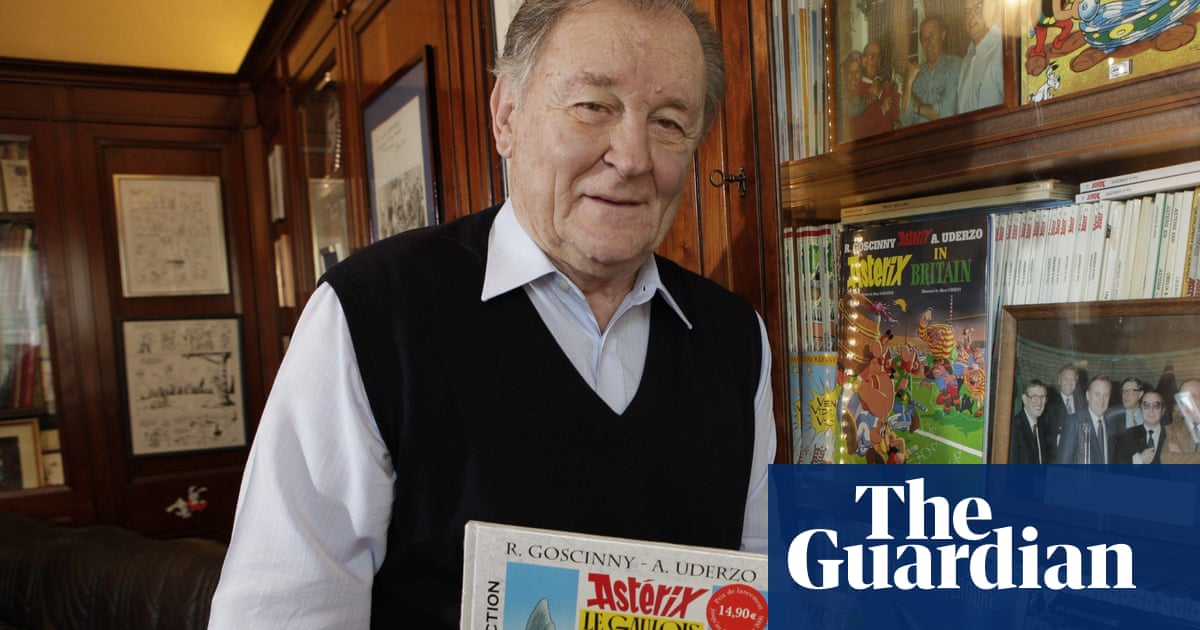You are using an out of date browser. It may not display this or other websites correctly.
You should upgrade or use an alternative browser.
You should upgrade or use an alternative browser.
Albert Uderzo
- Thread starter hydrovac
- Start date
eastofthesun
Well-Known Member
RIP in some way he touched all our lives with his art 
Bhaskar Jyoti Talapatra
Well-Known Member
Sad but it is the grimmest reality. A class by himself and an entertainer for the people of the global village.
flat_listener
Active Member
Albert Uderzo, who delighted legions of children and adults over the past six decades... sad to see him go, RIP.
RIP Mr. Albert & thanks to you & Mr. Goscinny for your wonderful childhood entertainment. Really enjoyed Asterix & Obelix along with Tintin . Each character in the comic stip was uniquely humourous especially their names well thought off. Their cartoon styling & humour was unique & difficult to come by in the future.
Last edited:
Fiftyfifty
Well-Known Member
Sad! Asterix was my favourite comic book character. Wonder what happened to Goscinny!
Just checked, Goscinny died in 1977 at age 51, after which Uderzo continued to write on his ownSad! Asterix was my favourite comic book character. Wonder what happened to Goscinny!
Asterix and Obelix was a huge part of my childhood.
Likewise here ..Sad. RIP.
M
mpw
Guest
Too many good people going..
Cacofonix..The bard...is what I have named my Lenco L75.
The loud raucous parties at the end..where they tie up Cacofonix and have a feast..was my favourite part of the book.
RIP sir.
Cacofonix..The bard...is what I have named my Lenco L75.
The loud raucous parties at the end..where they tie up Cacofonix and have a feast..was my favourite part of the book.
RIP sir.
The Guardian as usual has published some brilliant appraisals about the legacy of Uderzo.

 www.theguardian.com
www.theguardian.com

 www.theguardian.com
www.theguardian.com

 www.theguardian.com
www.theguardian.com
An excerpt from the first essay :
Perhaps this is why the news of the death of Albert Uderzo has hit so many so hard. For decades after the death of René Goscinny in 1977, he provided a living link to the golden age of the greatest series of comic books ever written: Paul McCartney to Goscinny’s John Lennon. Uderzo, as the illustrator, was better able to continue the series after Goscinny’s death than Goscinny would have been had Uderzo had died first, and yet the later books were, so almost every fan agrees, not a patch on the originals: very much Wings to the Beatles. What elevated the cartoons, brilliant though they were, to the level of genius was the quality of the scripts that inspired them. Again and again, in illustration after illustration, the visual humour depends for its full force on the accompaniment provided by Goscinny’s jokes.
Equally, though, the conceit that underlay Asterix would have been nothing without Uderzo. The challenge was to portray the age of Julius Caesar in a way that was true to the history and yet an utterly joyous recalibration of it. Brutality had to be portrayed as knockabout; a world of mud and gore and fire repainted in primary colours. Uderzo, who was colour blind, much preferred the clear line to any hint of shade, and it was that that enabled his drawings to redefine antiquity so distinctively in his own terms.
Brilliantly though he draws on the various traditions of Gallic metalwork, or Greek statuary, or Egyptian hieroglyphs to diversify his artwork, nowhere visited by Asterix and Obelix ever slips his ability to render both the Roman empire and the lands beyond its frontiers as belonging to a single, coherent comic world. Simultaneously, however, it is also a portrayal of a very different period: that of the decades after the second world war. No other postwar artist offered Europeans a more universally popular portrait of themselves, perhaps, than did Uderzo. The stereotypes with which he made such affectionate play in his cartoons – the haughty Spaniard, the chocolate-loving Belgian, the stiff-upper-lipped Briton – seemed to be just what a continent left prostrate by war and nationalism were secretly craving.

Asterix: a world of joyful innocence born in the aftermath of war
Goscinny and Uderzo’s cheery comic-book parodies reflected none of the real horror of Roman imperialism – and painted an irresistible portrait of postwar Europe

Illustrator Albert Uderzo drew me in to Asterix's world with deftness and care
The way Uderzo’s comic book panels progressed from rudimentary was an important lesson for a child

The art of Asterix: illustrator Albert Uderzo at work – in pictures
The French comic-book artist created the beloved character Asterix – scourge of the Roman invaders in ancient Gaul – with writer René Goscinny
An excerpt from the first essay :
Perhaps this is why the news of the death of Albert Uderzo has hit so many so hard. For decades after the death of René Goscinny in 1977, he provided a living link to the golden age of the greatest series of comic books ever written: Paul McCartney to Goscinny’s John Lennon. Uderzo, as the illustrator, was better able to continue the series after Goscinny’s death than Goscinny would have been had Uderzo had died first, and yet the later books were, so almost every fan agrees, not a patch on the originals: very much Wings to the Beatles. What elevated the cartoons, brilliant though they were, to the level of genius was the quality of the scripts that inspired them. Again and again, in illustration after illustration, the visual humour depends for its full force on the accompaniment provided by Goscinny’s jokes.
Equally, though, the conceit that underlay Asterix would have been nothing without Uderzo. The challenge was to portray the age of Julius Caesar in a way that was true to the history and yet an utterly joyous recalibration of it. Brutality had to be portrayed as knockabout; a world of mud and gore and fire repainted in primary colours. Uderzo, who was colour blind, much preferred the clear line to any hint of shade, and it was that that enabled his drawings to redefine antiquity so distinctively in his own terms.
Brilliantly though he draws on the various traditions of Gallic metalwork, or Greek statuary, or Egyptian hieroglyphs to diversify his artwork, nowhere visited by Asterix and Obelix ever slips his ability to render both the Roman empire and the lands beyond its frontiers as belonging to a single, coherent comic world. Simultaneously, however, it is also a portrayal of a very different period: that of the decades after the second world war. No other postwar artist offered Europeans a more universally popular portrait of themselves, perhaps, than did Uderzo. The stereotypes with which he made such affectionate play in his cartoons – the haughty Spaniard, the chocolate-loving Belgian, the stiff-upper-lipped Briton – seemed to be just what a continent left prostrate by war and nationalism were secretly craving.
M
mpw
Guest
I suppose wit and humour can survive and thrive in an environment that can laugh...at itself if necessary.
Yes for that there needs to be the environment where you are allowed to laugh and where your wit is cherished and appreciated.
Well, the conversation will take a different turn if we continue on this path.
Well, the conversation will take a different turn if we continue on this path.
M
mpw
Guest
Maybe Uderzo would had liked it.
Anyways..Some other time..
Anyways..Some other time..
Join WhatsApp Channel to get HiFiMART.com Offers & Deals delivered to your smartphone!
Similar threads
- Replies
- 0
- Views
- 205
- Replies
- 1
- Views
- 17K
- Replies
- 2
- Views
- 3K
- Replies
- 12
- Views
- 2K



